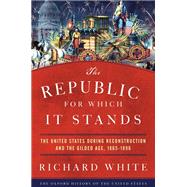
The Republic for Which It Stands The United States during Reconstruction and the Gilded Age, 1865-1896
by White, Richard-

Free Shipping On Orders Over $35
Your order must be $35 or more to qualify for free economy shipping. Marketplace items, eBooks and apparel do not qualify towards the $35 purchase minimum.
-
 eCampus.com Device Compatibility Matrix
eCampus.com Device Compatibility Matrix
Click the device icon to install or view instructions
Buy New
Rent Book
Rent Digital
Used Book
We're Sorry
Sold Out
How Marketplace Works:
- This item is offered by an independent seller and not shipped from our warehouse
- Item details like edition and cover design may differ from our description; see seller's comments before ordering.
- Sellers much confirm and ship within two business days; otherwise, the order will be cancelled and refunded.
- Marketplace purchases cannot be returned to eCampus.com. Contact the seller directly for inquiries; if no response within two days, contact customer service.
- Additional shipping costs apply to Marketplace purchases. Review shipping costs at checkout.
Summary
At the end of the Civil War the leaders and citizens of the victorious North envisioned the country's future as a free-labor republic, with a homogenous citizenry, both black and white. The South and West were to be reconstructed in the image of the North. Thirty years later Americans occupied an unimagined world. The unity that the Civil War supposedly secured had proved ephemeral. The country was larger, richer, and more extensive, but also more diverse. Life spans were shorter, and physical well-being had diminished, due to disease and hazardous working conditions. Independent producers had become wage earners. The country was Catholic and Jewish as well as Protestant, and increasingly urban and industrial. The "dangerous" classes of the very rich and poor expanded, and deep differences -- ethnic, racial, religious, economic, and political -- divided society. The corruption that gave the Gilded Age its name was pervasive.
These challenges also brought vigorous efforts to secure economic, moral, and cultural reforms. Real change -- technological, cultural, and political -- proliferated from below more than emerging from political leadership. Americans, mining their own traditions and borrowing ideas, produced creative possibilities for overcoming the crises that threatened their country.
In a work as dramatic and colorful as the era it covers, White narrates the conflicts and paradoxes of these decades of disorienting change and mounting unrest, out of which emerged a modern nation whose characteristics resonate with the present day.
Author Biography
Richard White is Margaret Byrne Professor of American History at Stanford University. He is the author of numerous prize-winning books, including Railroaded: The Transcontinentals and the Making of Modern America, The Middle Ground: Indians, Empires, and Republics in the Great Lakes Region, 1650-1815, and "It's Your Misfortune and None of My Own": A New History of the American West. He is a recipient of a MacArthur Fellowship, a Guggenheim Fellowship, and a Mellon Distinguished Scholar Award, among other awards.
Table of Contents
List of Maps
Editor's Introduction
Introduction
Part I: Reconstructing the Nation
Prologue: Mourning Lincoln
Chapter One: In the Wake of War
Chapter Two: Radical Reconstruction
Chapter Three: The Greater Reconstruction
Chapter Four: Home
Chapter Five: Gilded Liberals
Chapter Six: Triumph of Wage Labor
Chapter Seven: Panic
Chapter Eight: Beginning a Second Century
Part II: The Quest for Prosperity
Chapter Nine: Years of Violence
Chapter Ten: The Party of Prosperity
Chapter Eleven: People in Motion
Chapter Twelve: Liberal Orthodoxy and Radical Opinions
Chapter Thirteen: Dying for Progress
Chapter Fourteen: The Great Upheaval
Chapter Fifteen: Reform
Chapter Sixteen: Westward the Course of Reform
Chapter Seventeen: The Center Fails to Hold
Chapter Eighteen: The Poetry of a Pound of Steel
Part III: The Crisis Arrives
Chapter Nineteen: The Other Half
Chapter Twenty: Dystopian and Utopian America
Chapter Twenty-one: The Great Depression
Chapter Twenty-two: Things Fall Apart
Chapter Twenty-three: An Era Ends
Conclusion
Bibliographic Essay
Index
An electronic version of this book is available through VitalSource.
This book is viewable on PC, Mac, iPhone, iPad, iPod Touch, and most smartphones.
By purchasing, you will be able to view this book online, as well as download it, for the chosen number of days.
Digital License
You are licensing a digital product for a set duration. Durations are set forth in the product description, with "Lifetime" typically meaning five (5) years of online access and permanent download to a supported device. All licenses are non-transferable.
More details can be found here.
A downloadable version of this book is available through the eCampus Reader or compatible Adobe readers.
Applications are available on iOS, Android, PC, Mac, and Windows Mobile platforms.
Please view the compatibility matrix prior to purchase.

